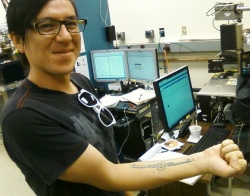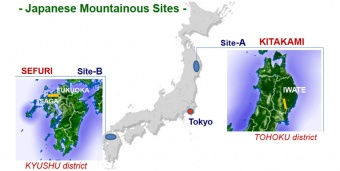Feature
A summer intern at Jefferson Laboratory is excited about the ILC – and he’s got the tattoo to prove it.
by Julianne Wyrick
How many people do you know with ILC tattoos? We know one, and he interned with Jefferson Lab’s Electron Gun Group this summer.
Video of the week
|
|
by Rika Takahashi
The site evaluation committee of Japan, set up under the Japan ILC Strategy Council, will hold a press conference on 23 August 2013, at 9:30 a.m. (Japan Standard Time) to announce the site selected as candidate site for the ILC. The press conference will be streamed live.
|
In the News
-
from Jiji press
16 August 2013
「国際リニアコライダー(ILC)」について、岩手・宮城両県の北上山地と、福岡・佐賀両県の脊振山地のどちらが建設候補地となるか、23日午前に東京大で発表されることになった。(The choice for the ILC construction site in Japan between Kitakami and Sefuri will be announced on 23 August at the University of Tokyo)
-
from SLAC Today
16 August 2013
My assessment is that Snowmass has been very successful in laying the foundation for the next phase of budget-constrained planning for the U.S. high energy physics program. It is anticipated that a subpanel of the High Energy Physics Advisory Panel (HEPAP) – the Particle Physics Project Prioritization Panel, or P5 – will be launched in September by the Department of Energy and the National Science Foundation, with a charge to provide a long-range strategy for high energy physics under various budget scenarios. Steve Ritz from UC-Santa Cruz has already been designated chair of the subpanel and the full membership of P5 will be finalized over the coming weeks.
-
from Nikkei
12 August 2013
「国際リニアコライダー」(ILC)の国内誘致の是非を検討してきた日本学術会議の有識者会議は12日、2~3年をかけて計画を精査し判断すべきだとの意見をまとめた。文部科学省は今回の意見を参考に総合判断するが、誘致に前向きな姿勢を崩していない。(The committee under the Science Council of Japan, which discussed the significance of the ILC, framed their response on 12 August that the project should be examined further over few years. The Ministry of Science, Education, Sports and Technology will take this recommendation into account, but retains the positive attitude toward invitation)
-
from NPR
12 August 2013
High on the agenda is a new collider to study the newly found Higgs particle. The Higgs was discovered at the Large Hadron Collider, a 17-mile underground ring that smashes protons together with an incredible amount of energy. The LHC is the perfect machine for finding the Higgs because when protons crash into each other, they create sprays of different particles, including the elusive Higgs.
But to study the Higgs in depth — and to produce only Higgs — researchers need to smash electrons and anti-electrons together, and this can only happen inside a new kind of collider.
-
from Kahoku Shinpo
09 August 2013
下村博文文部科学相は8日、閣議後の記者会見で、超大型加速器「国際リニアコライダー(ILC)」の誘致に関する政府の意思表明が、予定していた秋の臨時国会よりさらに遅れるとの見通しを示した。(Science minister of Japan, Hakubun Shimomura said on 8 August that government’s statement on the ILC invitation will be postponed. He said earlier that government will make statement in the extraordinary Diet session this fall.)
Copyright © 2025 ILC International Development Team




